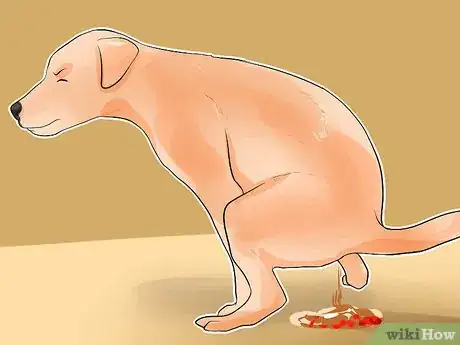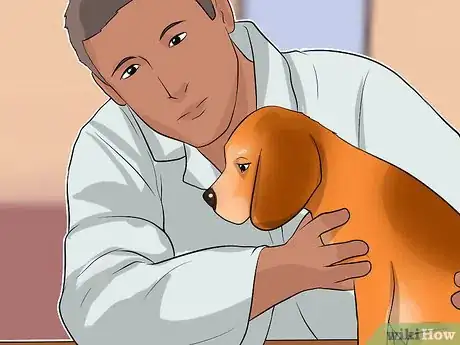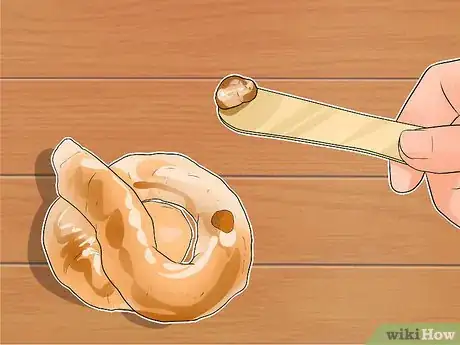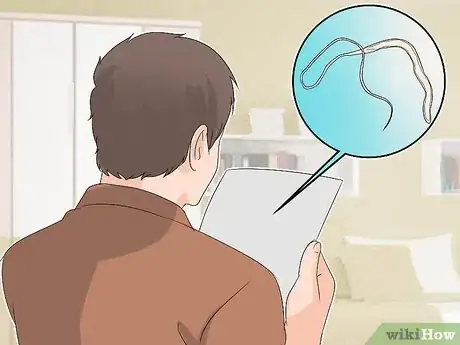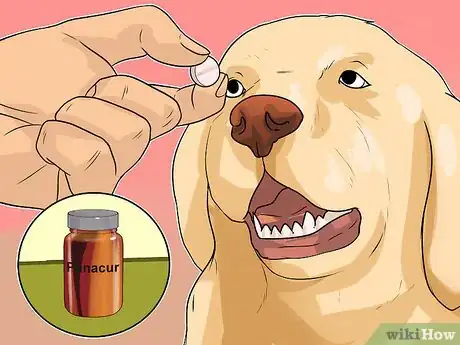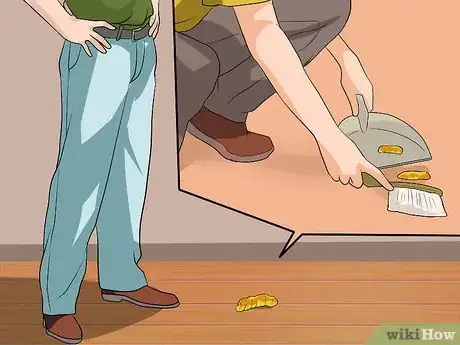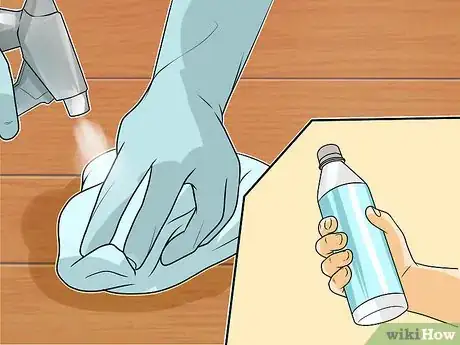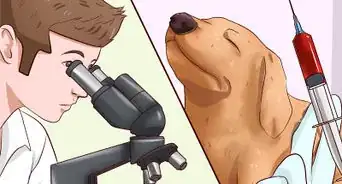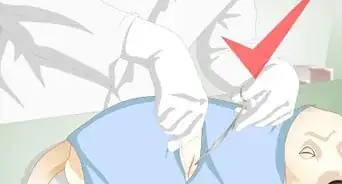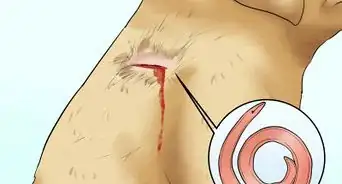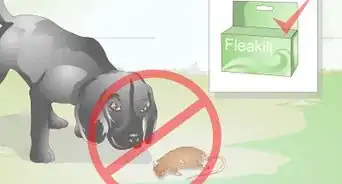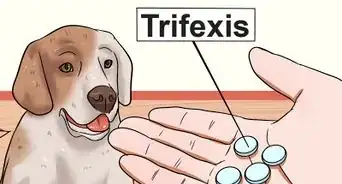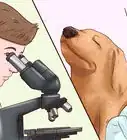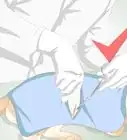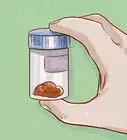This article was co-authored by Pippa Elliott, MRCVS. Dr. Elliott, BVMS, MRCVS is a veterinarian with over 30 years of experience in veterinary surgery and companion animal practice. She graduated from the University of Glasgow in 1987 with a degree in veterinary medicine and surgery. She has worked at the same animal clinic in her hometown for over 20 years.
This article has been viewed 41,058 times.
Whipworms (trichuris vulpis) are a common parasite that invades the intestines of dogs. It causes severe irritation of the lining of the gut wall, which results in bloody diarrhea.[1] Over time this leads to poor coat condition, weight loss, and general poor health. [2] If you have a dog, be sure you understand this infection, how to spot it, and how it's treated.
Steps
Identifying the Signs of a Whipworm Infection
-
1Keep an eye out for bouts of diarrhea. Whipworm infection should be suspected for any dog that suffers regular episodes of diarrhea, especially watery, bloody diarrhea. The diarrhea is caused by the whipworms attaching to the intestine wall and
- If the bloody diarrhea persists the dog is liable to become anemic, and signs of this include a lack of energy, and pale gums.[3]
-
2Look for signs of general poor health. This includes pale gums and a lack of energy, due to the anemia caused by the whipworms. In addition, the dog's coat can become dull and the dog can lose weight, due to a lack of nutrition cause by an inability to digest its food normally.[4]Advertisement
-
3Take your dog to its veterinarian. Any dog with persistent diarrhea, but especially bloody diarrhea, should see a vet. Call your veterinary office and tell them about the symptoms. They will tell you if you should bring your dog in right away and will give you an appointment to get your dog checked out.
- If you notice the problem during a time when your veterinary office is closed, you will need to gauge your dog's health and make a decision whether you need to take it to an emergency veterinary hospital. Your veterinary office may have a number you can call to get advice during an emergency.
Getting a Veterinary Diagnosis
-
1Bring a sample of your dog's feces with you to the veterinary office. If your dog has a history of bloody diarrhea, weight loss, anemia, and poor coat, then the vet will suggest a fecal flotation test. This involves submitting a sample of feces to the lab where they suspend the feces in special saline solution.[5] [6]
- Eggs float to the top where they can be captured and smeared onto a microscope slide for identification. The pathologist looks at the smear and identifies the characteristic lemon shaped egg of trichuris.
-
2Don't assume your dog is not infected if tests come back negative. The test for whipworms can come up with a false negative, yet it is currently the only diagnostic test. One problem of diagnosis is that signs of illness can become apparent before the adult worms start to shed eggs. This means that fecal sample tests can be falsely negative if the adult worms are present but they aren't yet at a stage in their life cycle where they produce eggs.
- It takes around 11 weeks from a dog being infected with whipworm eggs, for those eggs to hatch and produce adults that produce eggs.[7]
- However, prior to this the worms are developing in the bowel and damaging the bowel wall, producing symptoms.[8]
- In addition, another complication is that the female adult worms don't shed eggs all the time, but intermittently. Thus, even if you have reproductively-mature female worms present there is an element of luck as to whether they are shedding eggs at the time the sample is taken.[9]
-
3Follow your veterinarian's suggestions for treatment. Because false negative results are common on a fecal flotation test, it is acceptable to try a 'diagnosis by treatment'. This means treating the dog with an anthelmintic medicine that is effective against whipworm, and if the symptoms resolve then the case is proven.[10]
- Not all anthelmintics kill whipworm, so double check the product you use to make sure trichuris is within its spectrum of activity. These are mostly prescription products supplied by your vet,
Preventing Infection
-
1Give preventative treatments regularly. Because of the high risk of infection from eggs in the environment, it's important to keep your dog protected. Give regular repeat treatments every 3-4 months.[11]
- The good news is that many, but not all, heartworm preventatives are also effective against whipworm.
- The drugs effective against trichuris include fenbendazole (Panacur), Milbemycin (Interceptor, Milbemax, Sentinel), imidacloprid / moxidectin (Advantage), and Febantel / pyrantel / praziquantel (Drontal Plus)[12]
-
2Clean up dog feces in your yard or in areas that your dog frequents. It's important to practice good hygiene in your home and yard in order to limit your dog's exposure to this infection. It's particularly important to remove the feces of other dogs in areas that your dog frequents.[13]
- The infection is easily passed from dog to dog through the ingestion of infected feces.
-
3Avoid reinfection. Just because your dog has had an infection, and has been treated for it, doesn't mean the dog can't be easily reinfected. Part of the difficulty of dealing with whipworm infections is that the eggs are particularly hardy and can survive in the environment (even in concrete runs) for up to 5 years, making reinfection common.[14]
- In order to limit this, clean your home and yard top to bottom after your dog has been diagnosed. Remove all feces from your yard. Wash all linens and wash down all solid outdoor areas with bleach water.[15]
Warnings
- There is a slight chance that a whipworm infection can pass from your dog to humans. Make sure you practice good hygiene practices if your dog is infected and don't allow any kids into areas where an infected dog has gone to the bathroom.[16] You cannot get whipworms unless you ingest something contaminated with infected feces.⧼thumbs_response⧽
References
- ↑ http://www.vcahospitals.com/main/pet-health-information/article/animal-health/whipworm-infections-in-dogs/896
- ↑ http://www.peteducation.com/article.cfm?c=2+2090&aid=778
- ↑ http://www.vcahospitals.com/main/pet-health-information/article/animal-health/whipworm-infections-in-dogs/896
- ↑ http://www.cfsph.iastate.edu/Factsheets/pdfs/trichuriasis.pdf
- ↑ http://news.aces.illinois.edu/news/common-worms-your-pet-may-have-picked
- ↑ http://www.cfsph.iastate.edu/Factsheets/pdfs/trichuriasis.pdf
- ↑ http://www.cfsph.iastate.edu/Factsheets/pdfs/trichuriasis.pdf
- ↑ http://www.vcahospitals.com/main/pet-health-information/article/animal-health/whipworm-infections-in-dogs/896
- ↑ http://www.vcahospitals.com/main/pet-health-information/article/animal-health/whipworm-infections-in-dogs/896
- ↑ http://www.cfsph.iastate.edu/Factsheets/pdfs/trichuriasis.pdf
- ↑ http://www.petmd.com/dog/conditions/infectious-parasitic/c_multi_trichuriasis
- ↑ http://www.peteducation.com/article.cfm?c=2+2090&aid=778
- ↑ http://www.cfsph.iastate.edu/Factsheets/pdfs/trichuriasis.pdf
- ↑ http://www.peteducation.com/article.cfm?c=2+2090&aid=778
- ↑ http://www.cfsph.iastate.edu/Factsheets/pdfs/trichuriasis.pdf
- ↑ http://www.cfsph.iastate.edu/FastFacts/pdfs/trichuriasis_F.pdf
About This Article
To diagnose whipworms in your dog, observe if it is having regular bouts of bloody diarrhea, which is one of the most common signs of the condition. Since whipworms can prevent your dog from digesting its food properly, you should check if it has a dull coat or if it’s lost weight since these are signs of a lack of nutrition. Whipworms also cause anemia, so see if your dog has pale gums or a lack of energy. If you notice any of these symptoms, bring your dog to the vet to get a professional diagnosis. For more help from our Veterinary co-author, including how to prevent your dog from getting whipworms, read on!
